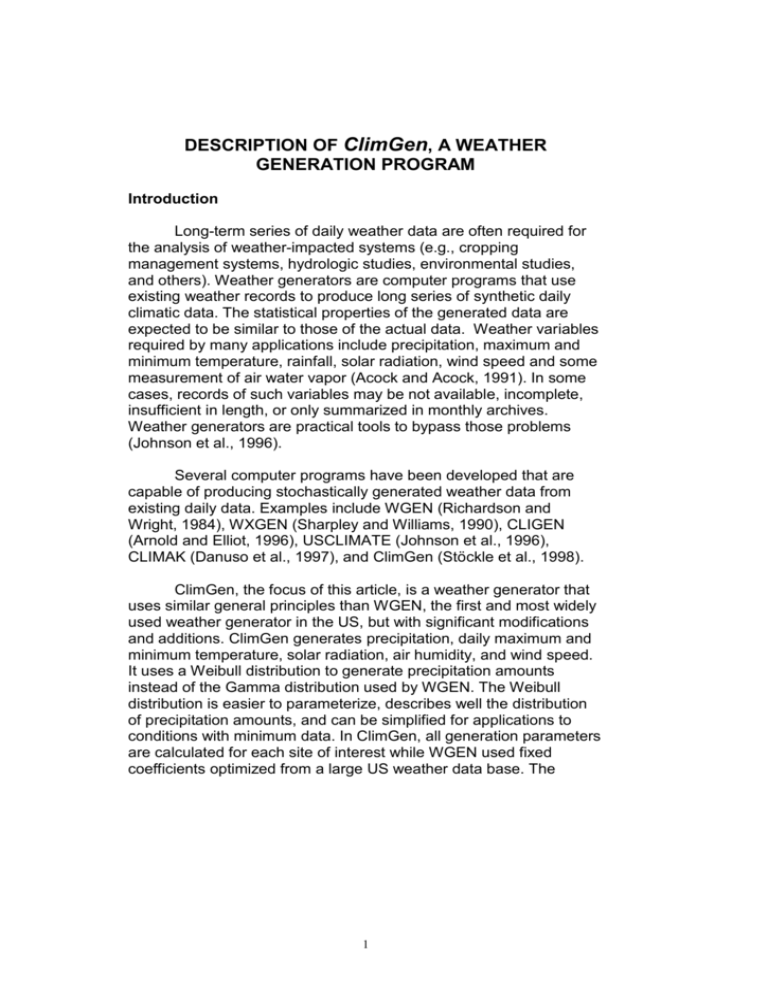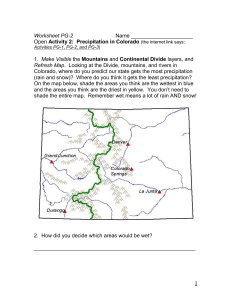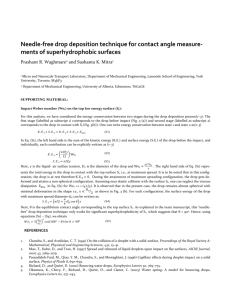Modeling the Atmospheric Environment: Precipitation, Temperature
advertisement

DESCRIPTION OF ClimGen, A WEATHER GENERATION PROGRAM Introduction Long-term series of daily weather data are often required for the analysis of weather-impacted systems (e.g., cropping management systems, hydrologic studies, environmental studies, and others). Weather generators are computer programs that use existing weather records to produce long series of synthetic daily climatic data. The statistical properties of the generated data are expected to be similar to those of the actual data. Weather variables required by many applications include precipitation, maximum and minimum temperature, rainfall, solar radiation, wind speed and some measurement of air water vapor (Acock and Acock, 1991). In some cases, records of such variables may be not available, incomplete, insufficient in length, or only summarized in monthly archives. Weather generators are practical tools to bypass those problems (Johnson et al., 1996). Several computer programs have been developed that are capable of producing stochastically generated weather data from existing daily data. Examples include WGEN (Richardson and Wright, 1984), WXGEN (Sharpley and Williams, 1990), CLIGEN (Arnold and Elliot, 1996), USCLIMATE (Johnson et al., 1996), CLIMAK (Danuso et al., 1997), and ClimGen (Stöckle et al., 1998). ClimGen, the focus of this article, is a weather generator that uses similar general principles than WGEN, the first and most widely used weather generator in the US, but with significant modifications and additions. ClimGen generates precipitation, daily maximum and minimum temperature, solar radiation, air humidity, and wind speed. It uses a Weibull distribution to generate precipitation amounts instead of the Gamma distribution used by WGEN. The Weibull distribution is easier to parameterize, describes well the distribution of precipitation amounts, and can be simplified for applications to conditions with minimum data. In ClimGen, all generation parameters are calculated for each site of interest while WGEN used fixed coefficients optimized from a large US weather data base. The 1 advantage is that ClimGen can be applied to any world location with enough information to parameterize the program. WGEN uses truncated Fourier series fits to produce daily values for monthlycalculated quantities of mean weather variables. This arbitrarily chosen functional form can lead to relatively poor fit to the data. ClimGen uses quadratic spline functions chosen to ensure that the average of the daily values are continuous across month boundaries, and that the first derivative of the function is continuous across month boundaries. Other features of ClimGen that are not available in WGEN include the generation of vapor pressure deficit (VPD) and wind speed. In addition, alternative approaches allow users to estimate VPD and solar radiation from existing temperature records. Brief description of ClimGen ClimGen provides utilities for computing all required generation parameters and statistical summaries from existing daily weather records. The methods for deriving these statistical summaries will not be discussed here. A brief description of the approach used to generate daily weather sequences follows. Generation of precipitation The generation of precipitation is based on two assumptions. One is that the rain condition on day i is related to the rain condition on day i-1, and the other is that the amount of rain on rainy days is described by a suitable distribution function. The first assumption describes a type of model called a Markov chain. Defining P(W/W) as the probability of a wet day on day i given a wet day on day i-1, and P(W/D) as the probability of a wet day on day i given a dry day on day i-1, then P(D/W) = 1- P(W/W) is the probability of a dry day given a wet day on day i-1 and P(D/D)= 1- P(W/D) is the probability of a dry day given a dry day on day i-1. These transition probabilities are calculated for each month at each location of interest. Daily values of these probabilities are interpolated using spline functions. If we know the state of today's weather (wet or dry), we immediately know the probability of a wet day tomorrow (either 2 P(W/W) or P(W/D)). ClimGen determines whether a particular day is wet or dry by subtracting P(W/W) or P(W/D) from a random number with a range of 0..1. If the result is greater than zero, the generator assumes no rain on that day. If it is less than or equal to zero, rain is assumed to have occurred, and the amount of rain is determined using a distribution function for rain amounts on wet days. Quadratic spline functions are used for daily interpolation of monthly probabilities of a wet day given a previous wet day and a wet day given a previous dry day. In the case of a wet day, the amount of precipitation is assumed to follow a Weibull distribution: P FP 1 exp [Eq. 1] where F(P) is the cumulative probability of a precipitation amount equal or less than P, and α and β are parameters of the distribution function that are calculated on a monthly basis. This distribution is sampled for each precipitation event using the inverse method. P ln( r ) 1/ [Eq. 2] where r is a random number between 0 and 1. Generation of temperature and solar radiation Daily maximum (Tx) and minimum (Tn) temperature and solar radiation (Rs) values are generated in a single operation. The time series of Tx, Tn and Rs are reduced to a time series of residual elements as follows: X p, i (j) - X ik (j) p, i (j) = ik (j) 3 [Eq. 3] where p, i (j) is the residual component for variable j (j=1 for Tx , j=2 for Tn and j=3 for Rs ) , year p and day i, Xp,i (j) is the daily value of the variable, X ik (j) and ik (j) the daily mean and standard deviation, with k=0 to indicate dry days and k=1 for wet days. The residual series for each variable are expected to be normally distributed with mean zero and variance of one, and described by a first order linear auto-regressive model. The weakly stationary generating multivariate process proposed by Matalas (1967) is used to generate the residual series as follows: p,i ( j ) A p,i 1 ( j ) B p,i ( j ) where [Eq. 4] p,i ( j ) and p,i 1 ( j ) are 3x1 matrices for day i and i-1 of year p whose elements are the residuals of Tx, Tn and Rs for day i and i-1 of year p respectively, p ,i ( j ) is a 3x1 matrix of independent random components normally distributed with mean zero and variance one, and A and B are 3x3 matrices whose elements are defined such that the new sequences have the desired serialcorrelation and cross-correlation coefficients. The A and B matrices are given by: A M 1 M 01 [Eq. 5] B B T M 0 A M 1T where superscripts -1 and T denote inverse and transpose respectively and M0 and M1 are 3x3 matrices whose elements are m0(p,q) and m1(p,q) respectively. The elements m0(p,q) are the lag-0 cross-correlation coefficients between residuals p , i ( p) and p, i (q) and m1(p,q) are the lag-1 cross-correlation coefficients between p , i ( p) and p , i 1 (q) , where p and q take on different values of j (i.e., j=1 for Tx , j=2 for Tn and j=3 for Rs ). 4 The A and B matrices are used with Eq.4 to generate new sequences of the residuals of Tx, Tn, and Rs that are serially correlated and cross-correlated. Daily generated values of Tx, Tn and Rs are determined by rearranging terms in Eq.3. to solve for Xp,i (j) and using the generated residuals to substitute for p, i (j) .The daily mean and standard deviation of Tx, Tn and Rs, conditioned on wet or dry status, are obtained from monthly values using spline functions. Generation of air humidity As a first step, daytime dew-point temperature (calculated concurrent with the time of minimum relative humidity and maximum temperature) and night dew-point temperature (calculated concurrent with the time of maximum relative humidity and minimum temperature) are determined from actual weather data as follows. e 0 (Tdd ) e 0 (Tx ) RH min 100 [Eq. 6] e 0 (Tdn ) e 0 (Tn ) RH max 100 [Eq. 7] where e0(T) is the saturation vapor pressure (kPa) determined at the specified temperature T. 17.27T e 0 (T ) 0.6108 exp T 237.3 [Eq. 8] Dew-point temperatures are obtained by inverting Eq. 8. A linear regression between daytime and night time dew point temperatures is calculated during the parameter optimization phase of ClimGen. 5 The second step is to calculate from data the daily maximum vapor pressure deficit (VPDmax), which is the maximum difference between saturation vapor pressure and actual vapor pressure. This is normally obtained at the time of minimum relative humidity and maximum temperature. RH min VPD max e 0 (Tx ) 1 [Eq. 9] 100 The daily maximum vapor pressure deficit can also be estimated from temperature. VPDmax e 0 (Tx ) - e 0 (Tn ) 1 - a [e 0 (Tx ) - e 0 (Tn )] [Eq. 10] where a (aridity factor) is a parameter optimized from data by combining Eqs. 9 and 10. After optimization of a, VPDmax from Eq.9 and 10 are correlated through a linear regression. Typically two years of humidity and temperature data are sufficient to parameterize ClimGen for air humidity data generation. During generation, ClimGen calculates VPDmax using Eq. 10, the optimized a parameter and linear regression slope and intercept, and generated Tx and Tn values. generates daily minimum relative humidity (RHmin) from generated Tx and Tn. Once VPDmax is determined, RHmin can be calculated from Eq. 9. Then, daytime dewpoint temperature can be calculated from RHmin and Eq. 6. Night time dew-point temperature can now be determined using the linear regression with daytime dew-point temperature. Finally, Eq. 7 can be used to calculate RHmax. Generation of wind This variable is generated without any correlation with other variables. Similarly to precipitation, daily wind speed (U) is represented using a Weibull distribution: 6 U FU 1 exp [Eq. 11] where F(U) is the cumulative probability of a wind speed amount equal or less than U, and α and β are parameters of the distribution function that are calculated on a monthly basis. This distribution is sampled for each day of weather generation using the inverse method. U ln( r ) 1 / [Eq. 12] where r is a random number ranging between 0 and 1. A Brief corroboration of ClimGen generation capabilities Methodology Data from thirteen world locations were available for this study (Table 1). All required parameters for weather generation were determined for each location. Using these parameters, daily series of weather data were generated and compared with actual data. The number of years of daily weather record generated corresponded to the length of the available record at each location. Comparisons for precipitation were only performed when the available record length was at least 25 years. Monthly mean and standard deviation, and the frequency distribution (probability of exceedence) were calculated from the daily series of generated and actual weather data. In addition, the occurrence of extreme values for weekly periods was calculated. To evaluate the agreement between actual and generated data, the following indices were used: Root Mean Square Error (RMSE), the General Standard Deviation ( GSD RMSE / O , where O is the mean of the actual data), and the Willmott (1982) index of agreement (d). The lowest limit of RMSE and GSD is 0, indicating perfect agreement between generated and actual values. The index of agreement ranges between 0 and 1, where a value of 1 indicates perfect agreement. For the interpretation of the performance indices, values of GSD0.10 and d0.95 were considered indicators of good 7 performance. Values of GSD>0.10 but 0.20 and values of d<0.95 but 0.90 were considered acceptable. Other values indicated poor performance. Results and discussion Results of comparisons between generated and actual daily weather, analyzed for monthly periods, are given in Table 2. Due to space limitations, the results presented are for selected locations, representative of overall performance. In most cases, an excellent agreement was obtained. Exceptions were found for the fraction of wet days and minimum temperature at some locations. However, even in those cases, the agreement was acceptable. Figure 1 compares, for selected locations, the probability of exceedence of actual and generated daily values for all the weather elements generated. These comparisons are given for illustration purposes, but again they are representative of overall performance. Similar results were obtained for all locations and weather variables (data not shown), showing a close agreement between the actual and generated frequency distributions of daily values. The comparisons between actual and generated extreme values for weekly periods are shown in Table 3. Large departures were observed in some cases, but all the generated values seemed plausible. Overall, the results of this evaluation show that the generation methods in ClimGen are sound. Conclusions Overall, results indicated a good performance of the ClimGen weather generator. In most cases, an excellent agreement between actual and generated weather was found for monthly period comparisons. Frequency distributions of actual and generated daily data were also in good agreement. Tests of extreme values for weekly periods showed that most generated values were plausible, with only a few significant departures between generated and actual values. The agreement between system responses, decision making, and/or interpretations based on actual and generated weather remains to be evaluated. 8 REFERENCES Acock, B. and M.C. Acock, 1991. Potential for using long-term field research data to develop and validate crop simulators. Agron. J. 83:56-61. Arnold, C.D. and W.J. Elliot, 1996. CLIGEN Weather Generator Predictions of Seasonal Wet and Dry Spells in Uganda. Trans. of ASAE 39(3):969-972. Danuso, F. et al., 1997. CLIMAK reference manual. DPVTA, University of Udine, Italy, 36 p. Johnson, G.L., C.L. Hanson, S.P. Hardegree and E.B. Ballard, 1996. Stochastic Weather Simulation: Overview and analysis of two commonly used models. Journal of Applied Meteorology 35:1878-1896. Matalas, N.C., 1967. Mathematical assessment of synthetic hydrology. Water Resources Research 3(4):937-945. Richardson, C.W., 1982. Dependence structure of daily temperature and solar radiation. Trans. of ASAE 25:735-739. Richardson, C.W. and D.A. Wright, 1984. WGEN: A model for generating daily weather variables. USDA-ARS, 235 p. Sharpley, A.N., and J.R. Williams, 1990. EPIC-Erosion/Productivity Impact Calculator: 1. Model Documentation. US Department of Agriculture Technical Bulletin No. 1768, 235 p. Stockle, CO, P. Steduto, and R.G. Allen. 1998. Estimating daily and daytime mean VPD from daily maximum VPD. 5th Congress of the European Society of Agronomy, Nitra, The Slovak Republic. Stöckle, C.O., G.S. Campbell, and R. Nelson. 1999. ClimGen manual. Biological Systems Engineering Department, Washington State University, Pullman, WA, 28 p. Willmott, C.J. 1982. Some comments on the evaluation of model performance. Bulletin of American Meteorological Society 63:1309-1313. 9 Table 1. Locations and number of years of available weather record. Location Length of data record (years) Name Lat Long Precip Temp Akron CO, USA Dalby, Australia Haarveg, The Netherlands Los Baños, Philippines Katherine, Australia Kimberly ID, USA Lleida, Spain Manhattan KS, USA Pisa, Italy Prosser WA, USA Rodeplaat, S. Africa Tel Hadya, Syria Versailles, France 40.09º N 27.11º S 51.97º N 14.22º N 13.29º S 42.40º N 41.70º N 39.20º N 43.40º N 46.25º N 25.58º S 36.01º N 48.9º N 103.20º W 151.00º E 5.67º E 122.00º E 132.40º E 114.20º W 33 29 36 14 32 11 6 32 27 10 13 12 34 33 29 36 14 32 11 6 32 27 10 13 12 34 96.80º W 11.00º E 119.75º W 28.35º E 36.93º E 2.00º E *The daily vapor pressure was estimated based on early morning vapor pressure measurements. 10 Solar Rad 15 36 14 6 15 5 10 13 12 15 Rel Hum 36* 14* 6 5 10 12 - Wind speed 36 14 6 5 10 12 - Table 2. Statistics and indicators of agreement between generated and actual daily records summarized for monthly periods. Location Statistics P fwet Tmax Tmin St VPD Actual Mean 33.434 0.187 17.204 1.498 16.989 Stdev 27.490 0.076 10.670 9.459 6.480 Generated Mean 33.230 0.189 17.253 1.576 16.592 Stdev 25.916 0.074 10.573 9.327 6.328 Akron RMSE 4.382 0.014 0.376 0.310 0.457 GSD 0.020 0.075 0.022 0.206 0.027 d 0.999 0.989 0.999 0.999 0.998 Actual Mean 63.185 0.468 13.248 5.290 9.168 0.671 Stdev 9.840 0.047 6.890 5.109 6.101 0.396 Generated Mean 65.855 0.480 13.256 5.128 9.279 0.704 Stdev 10.599 0.068 6.747 5.178 6.031 0.404 Haarweeg RMSE 0.194 0.026 0.273 0.334 0.198 0.049 GSD 0.049 0.056 0.021 0.063 0.022 0.074 d 0.998 0.939 0.999 0.999 0.999 0.995 Actual Mean 80.386 0.220 33.912 19.449 Stdev 98.039 0.226 2.648 5.060 Generated Mean 80.733 0.221 33.988 19.425 Stdev 98.075 0.223 2.509 5.029 Katherine RMSE 4.833 0.016 0.196 0.161 GSD 0.007 0.075 0.006 0.008 d 0.999 0.998 0.998 0.999 Actual Mean 73.578 0.263 19.792 9.899 12.466 1.149 Stdev 30.518 0.083 6.778 5.641 6.422 0.546 Generated Mean 74.110 0.265 19.804 9.938 12.520 1.181 Stdev 32.573 0.093 6.904 5.766 6.463 0.739 Pisa RMSE 6.479 0.017 0.253 0.252 0.484 0.207 GSD 0.015 0.065 0.013 0.025 0.039 0.180 d 0.999 0.989 0.999 0.999 0.998 0.969 Actual Mean 24.635 10.359 17.309 2.540 Stdev 10.161 7.625 7.566 1.717 Generated Mean 24.499 10.245 16.982 2.554 Stdev 9.996 7.300 7.363 1.649 Tel Hadya RMSE 0.419 0.590 0.489 0.154 GSD 0.017 0.057 0.028 0.061 d 0.999 0.998 0.999 0.997 11 U 2.412 0.293 2.420 0.285 0.033 0.014 0.996 1.691 0.207 1.709 0.267 0.082 0.048 0.964 2.817 1.158 2.808 1.144 0.059 0.021 0.999 Table 3. Comparison of extreme values on a weekly basis. Location Maximum rain in a week (mm) act gen E(%) Akron 112.776 128.460 13.907 Haarweg 111.100 127.190 14.482 Katherine 235.100 270.600 15.100 Pisa 207.100 183.600 -11.347 Tel Hadya 73.900 63.910 -13.518 Mean Tmax of hottest Mean Tmin of coldest Mean St of most radiant week week week (MJ m-2 d-1) (ºC) (ºC) act gen E(%) act gen E(%) act gen E(%) 37.383 38.730 3.604 -26.903 -20.523 -23.715 30.853 30.254 -1.941 31.357 29.416 -6.191 -16.714 -9.251 -44.650 26.717 26.570 -0.551 41.414 43.304 4.564 3.871 4.913 26.900 36.314 37.411 3.021 -4.000 -4.001 0.036 26.734 26.627 -0.401 42.671 42.784 0.264 -7.671 -2.960 -61.415 30.543 30.499 -0.145 Location Mean VPDmax of driest week (kPa) Akron Haarweg Katherine Pisa Tel Hadya * E % Mean St of less radiant week (MJ m-2 d-1) act 4.439 0.592 1.835 3.614 gen. act. act. gen E(%) act 4.074 -8.213 0.229 -61.409 3.386 2.109 14.920 3.092 4.093 13.241 7.311 Mean VPDmax of most humid week (kPa) gen E(%) act 2.704 -20.152 0.051 3.133 1.324 0.085 6.001 -17.918 0.217 100 12 gen 0.015 0.094 0.244 Mean wind speed of most windy week (m s1 ) E(%) act gen E(%) -71.463 6.900 5.490 -20.435 11.139 4.136 3.550 -14.174 12.436 8.009 7.226 -9.783 50 Dalby 100 80 60 40 20 0 0.00 Akron 40 30 Daily Tmax (°C) Daily precip. (mm) 120 20 10 0 -100.00 0.20 0.40 0.60 0.80 35 Daily Solar rad. (MJ m-2 d-1) 10 0.20 0.40 0.60 0.80 Tel Hadya 30 15 Daily Tmin (°C) 1.00 Probability of exceedence Versailles 20 1.00 25 20 15 10 -10 5 -15 0 0.00 -20 0.20 Probability of exceedence 0.40 0.60 0.80 1.00 Probability of exceedence 6 10 Haarweg 5 Daily Wind sp. (m s-1) Daily VPDmax (kPa) 0.80 -30 1.00 25 4 3 2 1 0 0.00 0.60 -20 0.20 Probability of exceedence 5 0 -50.00 0.40 0.20 0.40 0.60 0.80 1.00 Probability of exceedence Prosser 8 6 4 2 0 0.00 0.20 0.40 0.60 Probability of exceedence 0.80 Figure 1. Probability of exceedence of actual (solid line) and generated (dotted line) daily weather variables at selected sites. 13 1.00







